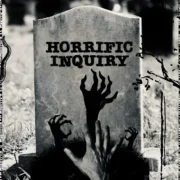EDWARD SCISSORHANDS: Tim Burton’s Timeless Masterpiece
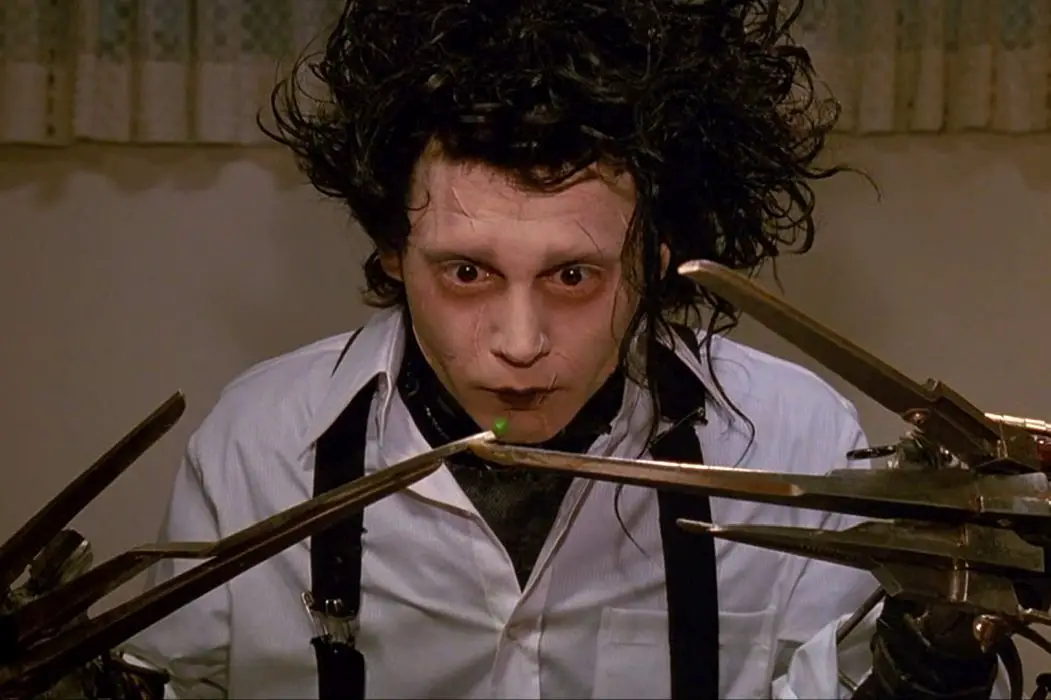
Alex Arabian is a freelance film journalist and filmmaker. His…
“Before he came down here, it never snowed. And afterwards, it did. I don’t think it would be snowing now if he weren’t still up there. Sometimes you can still catch me dancing in it.”
Every auteur has a particular style unique to their own. One could argue, however, that no filmmaker has a mind as imaginative as that of Tim Burton’s, one so indelibly characterizable that even the most casual filmgoer instantaneously knows when they are watching one of his films. Visually and stylistically, virtually all of his movies could seamlessly coexist in the same cinematic universe because of his sui generis visuals and unparalleled imagination.
Though, impressively, Burton has spanned almost every conceivable genre, narratively. Every great director has at least one masterpiece. Burton has several masterpieces in his filmography including Beetlejuice, Ed Wood, and Big Fish, along with The Nightmare Before Christmas as a writer and visual mastermind; all of these creations represent superior works of art that exemplify the best of a creative genius.
However good these films may be, Burton’s greatest artistic and cinematic achievement, his capolavoro remains Edward Scissorhands. His most personal work, is a film that represents the artistic outsider, one that uses a socially ill-equipped, misunderstood prodigal antihero, the titular character (Johnny Depp), to contrast his “normal” societal counterparts, providing intelligent social commentary about suburban America and humankind’s manmade, pun intended, prejudice against anything that is considered different. Burton’s Frankenstein update is also a love story for the ages and one of the most touching and heartbreaking onscreen romances in the history of film.
The History Behind Burton’s Magical Magnum Opus
Burton’s tragic gothic fantasy is the film that made me a cinephile. It has the same effect on me today as it did when I saw it as an eleven-year-old. I would not be writing this article today if Burton had not lived his childhood as a shut-in watching old Vincent Price films. This circular effect is what keeps cinema alive, it is what keeps its Burton-esque cogs grinding and rotating.
Being a fan of gothic horror, it is no secret that Burton is influenced by the story of Mary Shelley’s Frankenstein. He created the Disney-green-lighted animated short, Frankenweenie in 1984, a clever canine twist on the classic story of re-animation, which he remade into a feature length film some 25 years later. In between that time, Burton explored the classic story’s most prominent themes in Edward Scissorhands.
Burton has been captivated by scissors since a young age. As a child, he was enamored by the “simple and complicated” invention, but could’t figure out how to use them. This lays the groundwork for Edward, very much a child in a man’s body. The story of Edward Scissorhands was developed as a result of Burton’s suburban childhood upbringing in Burbank, California. It can be dated back to a single drawing during Burton’s teenage years of an early iteration of the Scissorhands character, which represented Burton’s feeling of isolation and his inability to hold friendships and communicate in a way that others around him had in Burbank.
In a biography by Helena Bassil-Morozow titled “Tim Burton: The Monster and the Crowd: A Post-Jungian Perspective”, Burton said, “I never really fell out with people, but I didn’t really retain friends. I get the feeling people just got this urge to want to leave me alone for some reason, I don’t know why exactly. It was as if I was exuding some sort of aura that said ‘Leave Me the Fuck Alone.'”
After the success of Beetlejuice and Batman, which were both produced by Warner Bros., Burton chose to adapt this story of suburban isolation to the big screen. After reading Caroline Thompson’s bizarre, gloomy novel, First Born, about an aborted child that comes back to life, Burton hired Thompson to adapt his story into a screenplay. For good reason, too, because, as Thompson said of Burton, “He’s the most articulate non-verbal person I know.” Within months, Warner Bros. had dropped the project, and Burton ultimately chose 20th Century Fox, which gave him complete creative autonomy of the project.
On top of Frankenstein, Thompson and Burton were heavily influenced by other classic Universal Horror films of a bygone era, including The Hunchback of Notre Dame (1923), The Phantom of the Opera (1925), and Creature from the Black Lagoon (1954). And to think, if Universal planned its current shared cinematic universe, which got off to a disastrous start with The Mummy, with somebody like Burton at the helm, it could have had some promise. The duo also took inspiration from King Kong (1933). As a result of their creative chemistry, Thompson would go on to script The Nightmare Before Christmas and Corpse Bride for Burton over the next 15 years.
Not only did Edward Scissorhands solidify Burton’s status as a singular talent in Hollywood, but it launched the career of Depp. Though it wasn’t always Depp slated to play Edward; Tom Cruise, Gary Oldman, Tom Hanks, John Cusack, and Jim Carrey were all considered to play the lead. Even Michael Jackson wanted to play the lead, but Burton wouldn’t offer him the role. Other notable actors who expressed interest in Edward were William Hurt and Robert Downey Jr.
Ultimately, Depp sold Burton with his ability to act with his eyes, and, according to Nina J. Easton of the Los Angeles Times, “after four seasons of a macho TV role [21 Jump Street] that transformed him into a teen-age heart-throb, Depp did a 180-degree turn, taking the lead role in a John Waters farce, Cry Baby,” which further impressed Burton. The fact that he was, at the time, Winona Ryder’s fiancé, who was the first person attached to the project, was mere coincidence. Depp claimed that “America has been sold this perception of me. [Fox] had this product, and in order to sell it they had to generate heat, so they sold this character I played on TV as if it were me.”
Bringing Out The Best In The Cast & Crew
With Edward Scissorhands, Depp, furthered even greater from the mainstream, and gave one of the most anomalous performances in the history of film. He portrays Edward with childlike wonder and authentic, transparent innocence. He prepared for the role with the mindset of a child, approaching everything, not solely the script alone, from a sheltered child’s perspective: curious, inquisitive, shy, and morally pure. However, as the audience finds out over the course of the film, that innocence and moral purity Edward possesses, though rare it may be, is corruptible.
It was a brave performance at a time in American cinema when being virile was still a pillar for male roles (Cruise was reportedly turned off of the role because of the lack of virility in Edward). As Ryder, who dropped out of The Godfather: Part 3 to play Kim, put it, “Johnny played it like a little boy, which is a tough thing to do for an actor. Actors have this thing; they don’t want to do anything to make them look innocent, naive, vulnerable. They all want to be macho, to carry a gun.”
Even among Depp’s extraordinary career, peering backwards in hindsight, Edward Scissorhands still remains a monumental undertaking and predominant standout. With such little dialogue for him to work with (only 169 words), Depp had to rely almost entirely on facial expressions, more particularly his eyes, displaying every emotion from astonishing wonderment to bitter anger. He watched old Charlie Chaplin films to help him master the art of emoting without dialogue.
“It was strange because it’s not like there was anything to base [my character] on. Edward is not a human being, he’s not an android, he’s not an alien. To me he was like a newborn baby, with that kind of innocence, or like a dog that gives unconditional love,” said Depp of his role. Indeed Thompson partly based the fleshed-out Edward on one of her old dogs who had a “preternaturally alert quality, but no way to communicate it. But for the physical constraints,” said Thompson, “I always felt she could speak.”
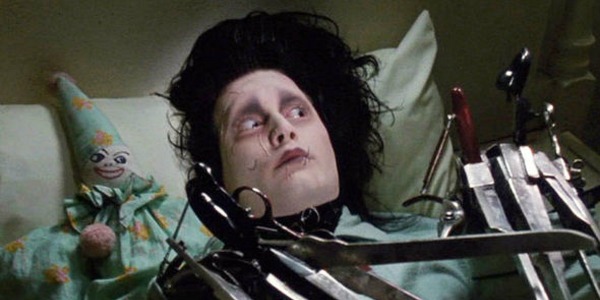
Of the many positive things that came out of this movie, one of its most important legacies is the marking of the dawn of the brilliant professional relationship between Burton and Depp. Along with Danny Elfman conducting the orchestra with his baton, the three of them, each with their own creative, unparalleled innovation in their respective craft, work so harmoniously together, they could make any subject transcribed to the silver screen enthralling.
Edward’s “adoptive” family is played to perfection by Dianne Wiest as the mother, Peg, Alan Arkin (played with dry wit and an infectiously hilarious aloofness) as the patriarch, Bill, Robert Oliveri as their son Kevin, and Ryder (in an unforgettable, star-making role) as the aforementioned, incandescent, eternally beautiful and empathetic daughter, Kim, and love interest of Depp’s Edward.
Our story begins with an elderly Kim reading her granddaughter a bedtime story, unbeknownst to the child, of her youth and encounters with Edward. And so, the viewer is transported to Burton’s faded, pastel-laden exaggeration of his Burbank suburb.
An Unforgettable Story Of Ill-Fated Lovers
Unfortunately for Edward, in this suburban fantasy land, Kim is dating Jim (Anthony Michael Hall in his first breakout role away from his, until then, awkward and nerdy teenager typecast), the quintessential jealous boyfriend character archetype, representing typical extreme masculinity. This love triangle, along with the overt change of heart towards Edward by the collective mind of the community, sets the stage for a Shakespearean-like tragedy.
Jim uses Edward’s particular “tools” to unwittingly commit a crime to carry out one of Jim’s personal vendettas. Edward gets caught, goes to jail, but refuses to place blame on Jim. Kim acknowledges this, and realizes his character and that she has reciprocal feelings for Edward. And so, the stage is set for the film’s climax.
Before the film’s calamitous, tragic ending, one of the most powerful, eternally enduring scenes in cinema history unfolds. Embracing the commercial holiday spirit of the neighborhood by adding his own, odd touch, Edward sculpts a giant ice statue of Kim on the front lawn, cuing composer and frequent Burton collaborator Danny Elfman‘s (also in his best work) orchestra to play the now famous “Ice Dance” number.
The cutting of the ice spawns snowflakes that fly from the sculpture in an array of directions, creating snowfall on the front lawn that illuminates incandescently in the moonlight. Eventually, Kim sees Edward on his ladder creating what would be his final public masterpiece, and begins to dance to Elfman’s magical number. This scene, with the way it was shot along with Stefan Czapsky’s ethereal cinematography, its brilliant score by Elfman, illustrious set design by Bo Welch and Cheryl Carasik, and visual effects by guru Stan Winston (winner of four Oscars for Aliens, two for Terminator 2, and Jurassic Park), will leave its lasting imprint in history along with the film long after humankind is gone.
An accident prompts Jim to chase Edward away from their block as he approaches the scene in a jealous rage. Later, a drunken Jim is hellbent on revenge, and a well-intentioned Edward tries again to do the right thing, but it is misinterpreted by the neighborhood. A manhunt ensues, and everyone runs Edward out of the neighborhood and back to his lonely abode, the gothic castle that sticks out like a sore thumb. Here, Kim finds Edward before the angry townspeople do, hiding in his attic. Not long after, Jim encounters them. Edward Scissorhands is a tragedy of misunderstandings that ends in unintended violence and the loss of Edward’s innocence. I will avoid details for those that haven’t seen the film.
The townspeople arrive at the castle to find a macabre scene. At this point, both Kim and Edward realize that this is goodbye. Kim kisses Edward on his scarred lips, and, with three simple words, makes his life worth living: “I love you”. They embrace one last time, Edward closing his eyes in such a way, as if to imagine a nonexistent future with Kim for just a few seconds. And like that, Kim leaves him just as Peg encountered him, a lonely soul lingering in the dark corner of his attic, alone amongst the eternal silence.
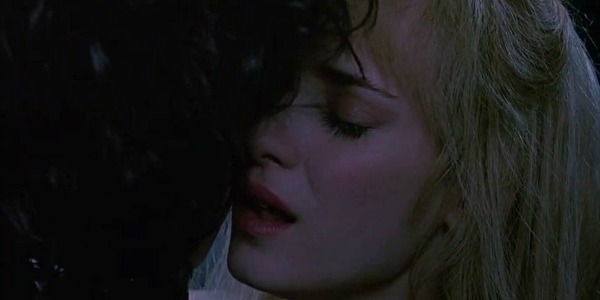
Kim lies to the neighborhood that Edward is dead, and, being the conditioned people society has sculpted (pardon the pun) them to be, they believe it and move on with their lives, onto the next hot topic or tomorrow’s gossip. Edward, however, was not made from society. He is his own sculptor, molding things to his own, unique liking.
As the elderly Kim’s narration comes to an end, her grandchild asks her how she knows this happened, to which Kim replies, “Because I was there,” the look of longing in her eyes. She explains that she never went back up to visit Edward because she wanted Edward to remember her as she was, not as she is now in her old age. They never saw each other again. It’s difficult to not discuss this plot point, as it brings out an important theme in Edward Scissorhands.
Being an inquisitive child, Kim’s granddaughter’s final question ponders how Kim knows Edward is still alive. Kim, in the final lines of the movie looking out of the window at the snowfall as the shot cuts to an ageless Edward sculpting the same ice statue in her memory, looking down on the city with wonder, explains, “Before he came down here, it never snowed. And afterwards, it did. I don’t think it would be snowing now if he weren’t still up there. Sometimes you can still catch me dancing in it.”
The snow pours out of Edward’s broken window as the film flashes back to Kim’s “Ice Dance” scene, one of the only moments of the film that omits any sense of exterior conflict or plot, focusing solely on the two star-crossed lovers basking in what would be their only fleeting moment of pure innocence together.
Burton & Thompson’s Themes Of American Suburbia & The Misunderstood Artist
In saying that Edward brought snow to their isolated suburban bubble, Kim is highlighting the lasting impact of diversity inclusion. The extent to which this should be taken literally or more as a metaphor to the viewer is irrelevant. Whether these people ever thought about Edward again or not, their lives were forever changed, their perspectives and outlooks on life slightly broadened.
Even though they ostracized and exiled him, he still brings joy to the neighborhood to this day; though his garden sculptures and quirky haircuts are no longer a pillar of the neighborhood, his legacy still lasts. The snowfall is a constant reminder of Edward’s unconscious lasting impact on the changing social constructs of the community and the communities it represented.
The story of Edward Scissorhands, stripped of its artistry, might sound a bit odd on paper, because, well, it is. As the great Vincent Price said of Burton, “There is a wonderful cartoon madness in his work, a kind of madness that doesn’t exist anymore in film.” Edward is a man who was created by an inventor (played by Price himself in an endearing role, his last film appearance before his death) who died before he could give him hands, leaving him with only scissors, hence his last name.
Edward lives in a mansion that is void of color, high up on a hill, starkly contrasting the vibrantly hued uniformity that represents Suburbia. He is confusingly “adopted” from his home by Peg and immediately submerged into modern-day society like a fish out of water. The word “modern-day” should be used loosely, as the film has no succinct feel of a particular time and place.
Traces of 1950s post-war suburban American society can be seen in the uniform, single-story modern home architecture, the neighbors’ matching old station-wagons, and Burton’s now-signature bird’s eye shots of every car pulling out of its own driveway in unison, representing the collective automation that suburban society created.
However, traces of the present day are also sprinkled within the world created by Burton in the form of modern technology, the evolution of white-American gentrification in the form of strip malls and cookie-cutter, pun-intended, commercially mass-produced products, and the cloyingly nosy nature of the residents of this neighborhood that acts as a cover-up for their petty, occasionally sinister grievances that they have developed as a result of decades of living in a suburban bubble, where the worst effects of capitalism have shown their nasty heads, subtly protruding throughout the film until exposing its full form in the film’s climax.
Burton uses this juxtaposition of time periods and the opposing natures of Edward to that of the collective community as a way of creating this exaggerated, suburban fantasy and highlighting sociopolitical issues of classism and institutional segregation; essentially, the members of the community represent the morally corrupted, living in excess without a care for anything outside of themselves or keeping up with ‘Jack and Nancy’ down the street.
On the contrary, Edward represents the innocent, childlike figure, unexposed to the neighborhood’s excesses and the negative consequences that accompany them. Edward, with his black, futuristic clothes (costume designer Colleen Atwood deserves major credit for bringing Burton’s vision to life), razor-sharp scissors for hands, pale skin, and contrastingly dark and disarrayed hair, is not the real monster, the members of his surrounding community are. They embraced Edward while simultaneously trashing him amongst each other.
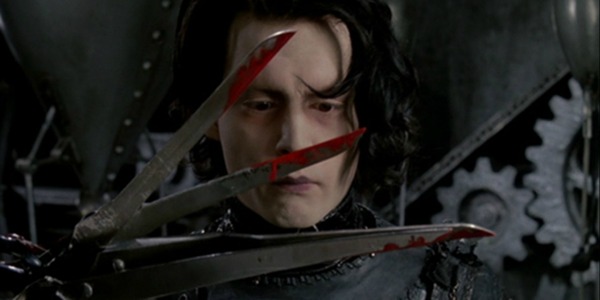
One resident, Esmeralda (O-Lan Jones), immediately deemed him Satin himself, and judged him while spewing hate and slurring profanities at anyone who associated with him. This is the first wave of prejudice Edward faces, and the first of many comically ironic scenarios. A considerable portion of the neighborhood became infatuated by him because he was different, embracing his natural aptitude for extravagant gardening and his peculiar eye for hair styling, while others hated him for that same reason.
Either way, eventually, everyone grew bored of him, just as they did with any passing fad or sensation in order to pass the time during their boring, monotonous lives. They chewed him up, tried to make him like them, corrupted him, and spit him out, eventually all sharing the same sentiment as Esmeralda originally did. And, like that, they moved on with their lives, shifting back into autopilot mode.
Edward Scissorhands: A Cinematic Miracle
On top of the fanciful foundation Burton provided the film through his story and creative mastery, Edward Scissorhands is one of those rare films where everything, every single aspect came together perfectly to create “movie magic”. Every time I use that phrase today, Edward Scissorhands is my precedent. It will give one the mystical feeling of escapism that movies of a long ago but not forgotten era in film sought to capture. To this day, I have yet to find the kind of magic in a film that was conveyed in Burton’s immortal masterpiece.
Joe Roth, former 20th Century Fox Chairman, had such high hopes for the film that he compared the anticipation of Edward Scissorhands to E.T., predicting that it would have the same emotional and cultural impact that the Steven Spielberg film did. In many ways, it has had the same effect. With Burton’s surreal illustrative ingenuity, Depp and Ryder’s marvelous, career-making performances, and a story filled with both simplicity and complexity and an intangible element of wizardry that stands the test of time, Edward Scissorhands is one of the greatest films ever made.
Does Edward Scissorhands rank among your favorite Christmas films? What is your favorite Tim Burton creation?
Edward Scissorhands opened on December 14, 1990 in the U.S. For more information on its release, see here.
https://www.dailymotion.com/video/x54yywx
Does content like this matter to you?
Become a Member and support film journalism. Unlock access to all of Film Inquiry`s great articles. Join a community of like-minded readers who are passionate about cinema - get access to our private members Network, give back to independent filmmakers, and more.
Alex Arabian is a freelance film journalist and filmmaker. His work has been featured in the San Francisco Examiner, The Playlist, Awards Circuit, and Pop Matters. His favorite film is Edward Scissorhands. Check out more of his work on makingacinephile.com!













